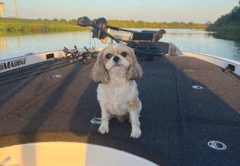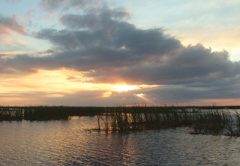
Bass Fishing on Lake Istokpoga and Lake Okeechobee
Bass Fishing on Lake Okeechobee and Lake Istokpoga over the last few weeks of November and into the early days of December has not been without its challenges. For those of you who have been on the water, you’re all too aware of the windy conditions since mid-November.
I’ve been out a number of times on Lake Istokpoga, fishing with folks from up north who were hoping to enjoy our balmy weather in search for lunker bass. The weather for the most part has been balmy, typically in the low to mid-80’s, but the wind, blowing fiercely out of the north and northeast at 15-25 mph has made fishing much tougher than it should be for this time of the year.
Thank God for Power Poles. Many of the areas I’d normally fish this time of the year were impossible to fish, but we caught some nice bass along the north and northeast shorelines of Lake Istokpoga where we had some relief from the wind. The bass are in a pre-spawn mode, sitting off-shore in 5-7’ of water, surrounded by hydrilla pods.
The best day on the lake yielded 6 bass weighing 3-5 pounds and one topping out at just over 7. Although we tried flipping the pencil reeds, bulrushes and pads, only one fish, a small 12” bass was taken on a Gary Yamamoto blue/black Senko worm. Most of the fish were caught in the deeper water using weighted flukes, Medlock jigs and plastic worms.
THE KEY TO FISHING THIS TIME OF THE YEAR IS TO GET OUT AHEAD OF THE COLD FRONTS.
The challenge was placing the bait in the pockets of hydrilla, allowing for a slow fall and then just letting the bait sit there, with an occasional twitch of the rod. Most were “soft” bites, often without us even knowing we’d had a strike until we lifted the bait and felt the weight, or watched our line moving off in a different direction.
The biggest bass came out of the mixed vegetation in front of Trails End Fishing Resort. The 7 pounder struck a black Gambler Cane Toad in about 2’ of water, bringing with her about 10 pounds of assorted grass and pads into the landing net. For my client, Sam Wilkins, it was his biggest bass yet!
The male bass in Lake Istokpoga should start moving into the shallower water over the next few weeks in search of bedding areas, preparing them for the larger females to lay their eggs.
The first females to move in will typically be the largest fish in the lake, and depending on the weather conditions, could move in as early as mid- December. Most of the females will remain off-shore in holding patterns until January and February when the male has completed the bed and moved out to coax a female into the shallower water to lay her eggs.
I fished Lake Okeechobee out of Harney Pond in early December and the spawning activity has already begun there. Although the water is too dark to see many of the beds, we caught dozens of smaller males on plastic worms in and around Fisheating Bay and Bird Island as well as some nice 3-5 pound females loaded with eggs.
The bass spawn earlier on Lake Okeechobee than on Lake Istokpoga due to the fact that Lake Okeechobee is much further south. Lake Istokpoga is usually a month or two behind Lake Okeechobee, although weather conditions play a big part in both lakes as to when the majority of fish will spawn.
This is the time of the year to catch some of the largest bass of the year as they come into the shallow water to spawn. The big females, often moving into the shallows in large numbers, typically remain shallow for a minimal amount of time. Males, on the other hand will often remain on the bed, protecting the eggs and eventual hatching of the fry, as well as guarding the fry for the first 7-10 days.
The males will be super aggressive, striking anything that comes near their nest. Great care should be taken to release them, since they’ll typically return quickly to the nest to guard the eggs or fry. Without their protection, a bed full of eggs can be quickly gobbled up by roving bands of bluegills and other panfish. Females caught off the beds represent the future of bass fishing and they too require delicate handling so their ability to release their eggs isn’t hampered. Most will move back off-shore after laying their eggs to rest and recuperate.
The key to fishing this time of the year is to get out ahead of the cold fronts. Once a cold front comes through the area, depending on its severity, the bass will often move off the beds and seek deeper water or cover. This can happen often, sometimes every two to three days. Based on the frequency and timing of these cold fronts over the next few months, in some cases, large females driven off their beds to many times will end up not laying their eggs at all and their bodies simply re-absorb the eggs until next years’ spawn.
Many people believe the best fishing of the year will occur 6 days prior to the full moon in January, February and March. Although disputed by some biologists, my experience has proven that the full moon periods of January, February and March can and often do produce some of the best bass-fishing of the year.






